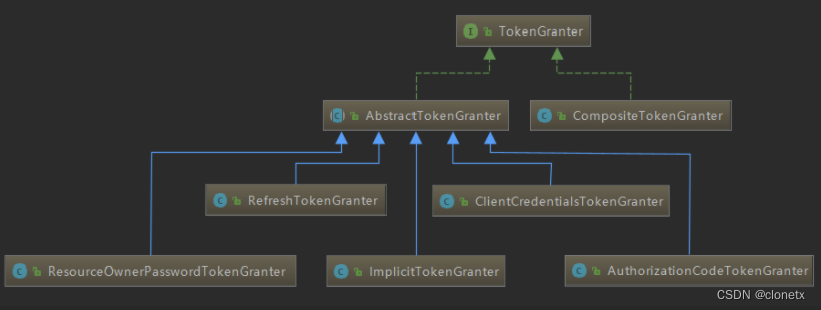本文主要是介绍SpringSecurity之OAuth2 令牌accessToken的生成过程,希望对大家解决编程问题提供一定的参考价值,需要的开发者们随着小编来一起学习吧!
使用过SpringSecurity Oauth2的小伙伴都知道,authorization_code、password、client_credentials、refresh_token几种授权模式获取token调用的接口都是/oauth/token,同时也都需要携带 client_id、client_secret 两个参数,或者说携带请求头
Authorization: Basic base64Encode(client_id_value:client_secret_value)这里的 Basic token 对应由 SpringSecurity 的过滤器 BasicAuthenticationFilter 进行验证处理。
1 BasicAuthenticationFilter
不同版本的springcloud中,doFilterInternal 的实现写法可能不同,但是核心逻辑是一样的。
了解 SpringSecurity 认证机制的小伙伴们看到下面的 authenticationManager.authenticate()方法就可以知道,这个过滤器用 client_id和client_secret 作为用户名和密码进行了一次认证,而对应的provider用来查询用户信息的实际就是ClientDetailsUserDetailsService。
在认证成功后将client的认证信息放在了SecurityContextHolder的线程变量中。
protected void doFilterInternal(HttpServletRequest request, HttpServletResponse response, FilterChain chain) throws IOException, ServletException {try {UsernamePasswordAuthenticationToken authRequest = this.authenticationConverter.convert(request);if (authRequest == null) {this.logger.trace("Did not process authentication request since failed to find username and password in Basic Authorization header");chain.doFilter(request, response);return;}String username = authRequest.getName();this.logger.trace(LogMessage.format("Found username '%s' in Basic Authorization header", username));if (this.authenticationIsRequired(username)) { //核心代码Authentication authResult = this.authenticationManager.authenticate(authRequest);SecurityContext context = SecurityContextHolder.createEmptyContext();context.setAuthentication(authResult);SecurityContextHolder.setContext(context);if (this.logger.isDebugEnabled()) {this.logger.debug(LogMessage.format("Set SecurityContextHolder to %s", authResult));}this.rememberMeServices.loginSuccess(request, response, authResult);this.onSuccessfulAuthentication(request, response, authResult);}} catch (AuthenticationException var8) {SecurityContextHolder.clearContext();this.logger.debug("Failed to process authentication request", var8);this.rememberMeServices.loginFail(request, response);this.onUnsuccessfulAuthentication(request, response, var8);if (this.ignoreFailure) {chain.doFilter(request, response);} else {this.authenticationEntryPoint.commence(request, response, var8);}return;}chain.doFilter(request, response);}2 TokenEndpoint
与一般的认证流程略有不同,上面的 this.onSuccessfulAuthentication(request, response, authResult);是空实现,因此,认证成功后,过滤器就会放行,然后请求进入TokenEndpoint。
当我们看到下面的代码的@RequestMapping就知道,这里一定就是生成token的入口了。可能有部分小伙伴会疑惑,为什么TokenEndpoint的注解是@FrameworkEndpoint而不是@Controller,看到@Component也就恍然了。
@Component
@Retention(RetentionPolicy.RUNTIME)
@Target(ElementType.TYPE)
public @interface FrameworkEndpoint {}postAccessToken()方法的入参有两个,parameters 比较好理解,就是request中的参数,而 principal 其实就是从 SecurityContextHolder线程变量拿到的上一步的认证信息
@FrameworkEndpoint
public class TokenEndpoint extends AbstractEndpoint { ......@RequestMapping( value = {"/oauth/token"},method = {RequestMethod.POST})public ResponseEntity<OAuth2AccessToken> postAccessToken(Principal principal, @RequestParam Map<String, String> parameters) throws HttpRequestMethodNotSupportedException {if (!(principal instanceof Authentication)) {throw new InsufficientAuthenticationException("There is no client authentication. Try adding an appropriate authentication filter.");} else {String clientId = this.getClientId(principal);ClientDetails authenticatedClient = this.getClientDetailsService().loadClientByClientId(clientId);TokenRequest tokenRequest = this.getOAuth2RequestFactory().createTokenRequest(parameters, authenticatedClient);if (clientId != null && !clientId.equals("") && !clientId.equals(tokenRequest.getClientId())) {throw new InvalidClientException("Given client ID does not match authenticated client");} else {if (authenticatedClient != null) {this.oAuth2RequestValidator.validateScope(tokenRequest, authenticatedClient);}if (!StringUtils.hasText(tokenRequest.getGrantType())) {throw new InvalidRequestException("Missing grant type");} else if (tokenRequest.getGrantType().equals("implicit")) {//这里不支持implicit模式获取tokenthrow new InvalidGrantException("Implicit grant type not supported from token endpoint");} else {if (this.isAuthCodeRequest(parameters) && !tokenRequest.getScope().isEmpty()) {this.logger.debug("Clearing scope of incoming token request");tokenRequest.setScope(Collections.emptySet());}if (this.isRefreshTokenRequest(parameters)) {tokenRequest.setScope(OAuth2Utils.parseParameterList((String)parameters.get("scope")));}OAuth2AccessToken token = this.getTokenGranter().grant(tokenRequest.getGrantType(), tokenRequest);if (token == null) {throw new UnsupportedGrantTypeException("Unsupported grant type: " + tokenRequest.getGrantType());} else {return this.getResponse(token);}}}}}......
}抛开校验逻辑,这段代码比较重要的就是下面几行。
1、首先查询了客户端信息(对应的数据库表就是oauth_client_details)
2、接下来用客户端信息和request中的参数构建了一个TokenRequest对象,
3、最后以tokenRequest作为参数,生成了我们最终需要的token.
显然,这里最重要的部分就是this.getTokenGranter().grant()方法
......
ClientDetails authenticatedClient = this.getClientDetailsService().loadClientByClientId(clientId);
TokenRequest tokenRequest = this.getOAuth2RequestFactory().createTokenRequest(parameters, authenticatedClient);
......
OAuth2AccessToken token = this.getTokenGranter().grant(tokenRequest.getGrantType(), tokenRequest);
关于TokenRequest,我们通过它的构造器基本上就可以了解这个对象包含了哪些属性。
public TokenRequest(Map<String, String> requestParameters, String clientId, Collection<String> scope, String grantType) {this.setClientId(clientId);this.setRequestParameters(requestParameters);this.setScope(scope);this.grantType = grantType;}而对于 this.getTokenGranter(),它的具体实现是在AuthorizationServerEndpointsConfigurer#tokenGranter()方法,那么接下来的重点源码就是AuthorizationServerEndpointsConfigurer类了。
至于为什么具体实现是上面这个方法,可以看TokenEndpoint 实例在初始化时的设置。 在AuthorizationServerEndpointsConfiguration.java 有这样一段代码。(有一点我不太明白,@Bean 和 @Componet 都是将bean注册到spring容器中,为什么可以同时存在)
@Beanpublic TokenEndpoint tokenEndpoint() throws Exception {TokenEndpoint tokenEndpoint = new TokenEndpoint();tokenEndpoint.setClientDetailsService(clientDetailsService);tokenEndpoint.setProviderExceptionHandler(exceptionTranslator());tokenEndpoint.setTokenGranter(tokenGranter());//设置token生成器tokenEndpoint.setOAuth2RequestFactory(oauth2RequestFactory());tokenEndpoint.setOAuth2RequestValidator(oauth2RequestValidator());tokenEndpoint.setAllowedRequestMethods(allowedTokenEndpointRequestMethods());return tokenEndpoint;}3 AuthorizationServerEndpointsConfigurer
SpringSecurity实现OAuth2分为两个服务,Authorization Server和Resource Server分别作为授权服务器和资源服务器,我们在配置授权服务器的时候会有如下配置。显然这里的配置就是为了生成token使用的。
@Overridepublic void configure(AuthorizationServerEndpointsConfigurer endpoints) throws Exception {endpoints.pathMapping("/oauth/token","/clonetx/token").allowedTokenEndpointRequestMethods(HttpMethod.GET, HttpMethod.POST)//允许的请求方式//tokenStore默认内存存储,重启服务token就会失效.tokenStore(new InMemoryTokenStore())//.accessTokenConverter(jwtAccessTokenConverter())//用于配置密码式的授权方式,如果不设置,密码模式请求token是,token为null,TokenEndpoint会提示不支持password授权模式//其实这里配置就是parent AuthenticationManager//.authenticationManager(authenticationManager())/*.tokenGranter(new TokenGranter() {@Overridepublic OAuth2AccessToken grant(String s, TokenRequest tokenRequest) {return null;}})*/;}在分析this.getTokenGranter().grant()方法的源码之前,我们先看下 TokenGranter 的类图。
 通过类图,能够清晰的看到,TokenGranter 有6个实现类,其中通过名称我们就能知道,其中5个实现类分别对应refresh_token、client_credentials、password、authorization_code、implicit几种grantType。(其中implicit模式不由/oauth/token处理,具体可以看上面略过的校验逻辑,这里不进行展开)。
通过类图,能够清晰的看到,TokenGranter 有6个实现类,其中通过名称我们就能知道,其中5个实现类分别对应refresh_token、client_credentials、password、authorization_code、implicit几种grantType。(其中implicit模式不由/oauth/token处理,具体可以看上面略过的校验逻辑,这里不进行展开)。
我们带着剩下的 CompositeTokenGranter 实现类来看下面这段代码,可以知道,如果配置AuthorizationServerEndpointsConfigurer endpoints的时侯没有指定token生成器,那么默认就会使用 CompositeTokenGranter
private TokenGranter tokenGranter() {if (tokenGranter == null) {tokenGranter = new TokenGranter() {private CompositeTokenGranter delegate;@Overridepublic OAuth2AccessToken grant(String grantType, TokenRequest tokenRequest) {if (delegate == null) {// 获取 oauth2 的 5 种 token 生成器delegate = new CompositeTokenGranter(getDefaultTokenGranters());}// 把auth2 的 5 种 token 生成器遍历了一次,根据grantType 选择对应的生成器,都不满足的就返回空return delegate.grant(grantType, tokenRequest);}};}return tokenGranter;}显然,CompositeTokenGranter是那 5 种 token 生成器的代理类,根据 grantType 来选择对应的生成器,并通过代理对象的grant()方法生成token。(这里我们需要关注一下 tokenServices() 方法,后面生成token的逻辑就在它的实现代码中。可以发现endpoints配置中没有指定就会默认DefaultTokenServices,当然对于其它配置也是一样的,不在endpoints配置中指定就会取默认的,这里就不展开说明了)
private List<TokenGranter> getDefaultTokenGranters() {ClientDetailsService clientDetails = clientDetailsService();//设置了产生token的serviceAuthorizationServerTokenServices tokenServices = tokenServices();AuthorizationCodeServices authorizationCodeServices = authorizationCodeServices();OAuth2RequestFactory requestFactory = requestFactory();//token 生成器List<TokenGranter> tokenGranters = new ArrayList<TokenGranter>();//N# 1 授权码模式token生成器tokenGranters.add(new AuthorizationCodeTokenGranter(tokenServices, authorizationCodeServices, clientDetails,requestFactory));//N# 2 刷新token 生成器tokenGranters.add(new RefreshTokenGranter(tokenServices, clientDetails, requestFactory));//N# 3 隐藏式生成器ImplicitTokenGranter implicit = new ImplicitTokenGranter(tokenServices, clientDetails, requestFactory);tokenGranters.add(implicit);//N# 4 客户端模式生成器tokenGranters.add(new ClientCredentialsTokenGranter(tokenServices, clientDetails, requestFactory));if (authenticationManager != null) {//密码模式要求自定义一个authenticationManager parent//N# 5 密码式生成器tokenGranters.add(new ResourceOwnerPasswordTokenGranter(authenticationManager, tokenServices,clientDetails, requestFactory));}return tokenGranters;} private AuthorizationServerTokenServices tokenServices() {if (tokenServices != null) {return tokenServices;}this.tokenServices = createDefaultTokenServices();return tokenServices;} private DefaultTokenServices createDefaultTokenServices() {DefaultTokenServices tokenServices = new DefaultTokenServices();tokenServices.setTokenStore(tokenStore());tokenServices.setSupportRefreshToken(true);tokenServices.setReuseRefreshToken(reuseRefreshToken);tokenServices.setClientDetailsService(clientDetailsService());tokenServices.setTokenEnhancer(tokenEnhancer());//token增强器addUserDetailsService(tokenServices, this.userDetailsService);return tokenServices;}继续跟踪 delegate.grant() 方法,我们会发现,无论是无论是哪种授权模式,都会调用 AbstractTokenGranter中的grant方法。
4 AbstractTokenGranter
下面代码中的tokenServices 在 getDefaultTokenGranters()#tokenServices() 方法中已经指定,没指定默认就是DefaultTokenServices。
public OAuth2AccessToken grant(String grantType, TokenRequest tokenRequest) {if (!this.grantType.equals(grantType)) {return null;} else {String clientId = tokenRequest.getClientId();ClientDetails client = this.clientDetailsService.loadClientByClientId(clientId);this.validateGrantType(grantType, client);this.logger.debug("Getting access token for: " + clientId);return this.getAccessToken(client, tokenRequest);}} protected OAuth2AccessToken getAccessToken(ClientDetails client, TokenRequest tokenRequest) {return this.tokenServices.createAccessToken(this.getOAuth2Authentication(client, tokenRequest));}//这里RefreshTokenGranter是个例外,重写了getAccessToken 方法//@Override//protected OAuth2AccessToken getAccessToken(ClientDetails client, TokenRequest tokenRequest) {// String refreshToken = tokenRequest.getRequestParameters().get("refresh_token");// return getTokenServices().refreshAccessToken(refreshToken, tokenRequest);//}5 DefaultTokenServices
分析这段代码,首先是尝试从 tokenStore 中获取token,简单看一下TokenStore的部分实现类,就能推测出不同的实现类其实就是把token存放在不同的地方,默认是内存中,也是可以在endpoints配置的。

那么这段逻辑就是,判断一下是否已经为这个authentication生成过token,如果已经存在token,判断是否已经过期,没过期就返回这个token;否则就把 refreshToken 和 existingAccessToken从存储中先清理掉。
然后在来判断 refreshToken,如果不存在,说明以前没认证过,那就先生成一个refreshToken,如果存在但是过期了,也重新生成一个refreshToken。
最后就是利用 refreshToken 和 authentication重新生成一个accessToken了。然后再把新的token放到存储中。
@Transactionalpublic OAuth2AccessToken createAccessToken(OAuth2Authentication authentication) throws AuthenticationException {OAuth2AccessToken existingAccessToken = this.tokenStore.getAccessToken(authentication);OAuth2RefreshToken refreshToken = null;if (existingAccessToken != null) {if (!existingAccessToken.isExpired()) {this.tokenStore.storeAccessToken(existingAccessToken, authentication);return existingAccessToken;}if (existingAccessToken.getRefreshToken() != null) {refreshToken = existingAccessToken.getRefreshToken();this.tokenStore.removeRefreshToken(refreshToken);}this.tokenStore.removeAccessToken(existingAccessToken);}if (refreshToken == null) {refreshToken = this.createRefreshToken(authentication);} else if (refreshToken instanceof ExpiringOAuth2RefreshToken) {ExpiringOAuth2RefreshToken expiring = (ExpiringOAuth2RefreshToken)refreshToken;if (System.currentTimeMillis() > expiring.getExpiration().getTime()) {refreshToken = this.createRefreshToken(authentication);}}OAuth2AccessToken accessToken = this.createAccessToken(authentication, refreshToken);this.tokenStore.storeAccessToken(accessToken, authentication);refreshToken = accessToken.getRefreshToken();if (refreshToken != null) {this.tokenStore.storeRefreshToken(refreshToken, authentication);}到这里我们终于一层层的揭开了SpringSecurity Oauth2令牌生成的面纱,上面我们在注释中有提到过RefreshTokenGranter是个例外,它重写了getAccessToken 方法,但最终的实现也是调用的下面代码。
private OAuth2AccessToken createAccessToken(OAuth2Authentication authentication, OAuth2RefreshToken refreshToken) {DefaultOAuth2AccessToken token = new DefaultOAuth2AccessToken(UUID.randomUUID().toString());int validitySeconds = getAccessTokenValiditySeconds(authentication.getOAuth2Request());if (validitySeconds > 0) {token.setExpiration(new Date(System.currentTimeMillis() + (validitySeconds * 1000L)));}token.setRefreshToken(refreshToken);token.setScope(authentication.getOAuth2Request().getScope());return accessTokenEnhancer != null ? accessTokenEnhancer.enhance(token, authentication) : 我们看到accessToken原来就是个uuid。
客户端授权模式token例子
{"access_token": "b1394c16-0b9a-4101-b0ba-9237dbeb27ae","token_type": "bearer","expires_in": 1526,"scope": "test"
}不过到这并没完,还有一个扎眼的 accessTokenEnhancer.enhance(token, authentication)方法。我们上文在createDefaultTokenServices()的代码中,看到初始化tokenServices时设置了一个TokenEnhancer,见名知意,它可以对 token 进行额外的处理。这就不得不提到 JWT了,我们下次开一篇单独分析TokenEnhancer。
这篇关于SpringSecurity之OAuth2 令牌accessToken的生成过程的文章就介绍到这儿,希望我们推荐的文章对编程师们有所帮助!





